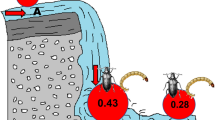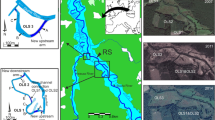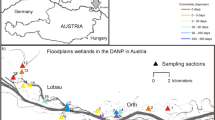Abstract
The habitat heterogeneity generated and sustained by the connectivity of floodplain habitats, the seasonal flood pulse, and the variability of the physical structures typically found in floodplains of large rivers results in a variable space–time mosaic of water sources that results in a high biodiversity of the river-floodplain system. In order to assess the implications of natural connectivity and the heterogeneity on the patterns of macroinvertebrate assemblages at different spatial scales, monthly samplings in six different mesohabitats (lakes with different hydrological connection and secondary channels with permanently and intermittent flow) of the Paraná River floodplain were performed from April 2005 to March 2006. The mesohabitats had different granulometry and detritus composition of their bottom sediments. They also had different conductivity, transparency, and depth in relation to the different connectivity degrees. Mesohabitats differed in the abundance of macroinvertebrates of different taxonomic groups and diversity. The environmental variables were correlated to the patterns of macroinvertebrate abundance, with dominance of different species of annelids and mollusks at the patch, mesohabitats, and island scales. An alpha diversity gradient from the isolated lake (65 taxonomic units) to the secondary channels (25 taxonomic units) was obtained. The analyzed mesohabitats showed a high taxa turnover, with high values not only among the mesohabitats located in the different islands, but also among the mesohabitats in relation to different connectivity degrees. The mesohabitats showed negative co-occurrence of macroinvertebrate assemblages. The spatial heterogeneity, sustained by the connectivity degree, played a key role in structuring benthic assemblages at different scales, positively influencing the regional diversity.





Similar content being viewed by others
References
Amoros, C. & G. Bornette, 2002. Connectivity and biocomplexity in waterbodies of riverine floodplains. Freshwater Biology 47: 761–766.
Amoros, C. & A. L. Roux, 1988. Interaction between water bodies within the floodplains of large rivers. Function and development of connectivity. In Schreiber, K. F. (ed.), Connectivity in Landscape Ecology. Münstersche Geographische Arbeiten 29. Münster, Germany: 125–130.
Arscott, D. B., K. Tockner & J. V. Ward, 2005. Lateral organization of aquatic invertebrates along the corridor of a braided floodplain river. Journal of the North American Benthological Society 24: 934–954.
Bechara, J. A., 1996. The relative importance of water quality, sediment composition and floating vegetation in explaining the macrobenthic community structure of floodplain lakes (Paraná River, Argentina). Hydrobiologia 333: 95–109.
Behrend, R. D. L., S. E. P. Fernandes, D. S. Fujita & A. M. Takeda, 2009. Eight years of monitoring aquatic Oligochaeta from the Baía and Ivinhema Rivers. Brazilian Journal of Biology 69: 559–571.
Bornette, G., C. Amoros & N. Lamouroux, 1998. Aquatic plant diversity in riverine wetlands: the role of connectivity. Freshwater Biology 39: 267–283.
Brown, J. H. & A. Kodric-Brown, 1977. Turnover rates in insular biogeography: effect of immigration on extinction. Ecology 58: 445–449.
Carignan, R. & J. J. Neiff, 1992. Nutrient dynamics in the floodplain ponds of the Paraná River (Argentina) dominated by Eichhornia crassipes. Biogeochemistry 17: 85–121.
Drago, E. C., I. Ezcurra de Drago, O. B. Oliveros & A. R. Paira, 2003. Aquatic habitats, fish and invertebrate assemblages of the Middle Paraná River. Amazoniana 17: 291–341.
Ezcurra de Drago, I., M. Marchese & L. Montalto, 2007. Benthic invertebrates. In Iriondo, H., J. C. Paggi & M. J. Parma (eds), The Middle Paraná River Limnology of a Subtropical Wetland. Springer-Verlag, Berlin, Heidelberg, New York, USA: 251–275.
Frissell, C. A., W. J. Liss, C. E. Warren & M. D. Hurley, 1986. A hierarchical framework for stream habitat classification: viewing streams in a watershed context. Environmental Management 10: 199–214.
Gotelli, N. J., 2006. Null versus neutral models: what’s the difference? Ecography 29: 793–800.
Grzybkowska, M. & J. Witczak, 1990. Distribution and production of Chironomidae (Diptera) in the lower course of the Grabia River (Central Poland). Freshwater Biology 24: 519–531.
Heiler, G., T. Hein, F. Schiemer & G. Bornette, 1995. Hydrological connectivity and flood pulses as the central aspects for the integrity of a river-floodplain system. Regulated Rivers Research and Management 11: 351–361.
Hieber, M., C. T. Robinson, U. Uehlinger & J. V. Ward, 2005. A comparison of macroinvertebrate assemblages among different types of alpine streams. Freshwater Biology 50: 2087–2100.
Hilty, J. A., W. Z. Lidicker Jr. & A. M. Merendeler, 2006. Corridor Ecology. Island Press, USA.
Ilg, C., F. Foeckler, O. Deichner & H. Klaus, 2009. Extreme flood events favor floodplain mollusk diversity. Hydrobiologia 621: 63–73.
Junk, W. J., 1999. The flood pulse concept of large rivers: learning from tropics. Archives für Hydrobiologie Supplement 115: 261–280.
Junk, W. J., P. B. Bayley & R. E. Sparks, 1989. The flood pulse concept in river-floodplain systems. Canadian Special Publications on Fisheries and Aquatic Sciences 106: 110–127.
Loreau, M., N. Mouquet & R. D. Holt, 2003. Meta-ecosystems: a theoretical framework for spatial ecosystem ecology. Ecology Letters 6: 673–679.
Marchese, M., 1987. The ecology of some benthic Oligochaeta from Paraná River, Argentina. Hydrobiologia 155: 209–214.
Marchese, M. R. & I. Ezcurra de Drago, 2006. Bentos como indicador de condiciones tróficas. In Tundisi, J., T. Matsumura Tundisi & C. Sidagis Galli (eds), Eutrofização na América do Sul: Causas, Consequências e Tecnologias de Gerenciamento e Controle. Instituto Internacional de Ecologia e Gerenciamento Ambiental, Academia Brasileira de Ciências, Conselho Nacional de Desenvolvimento Científico e Tecnológico, Inter Academy Panel on International Issues, InterAmerican Network of Academies of Sciences, Brazil: 297–316.
Marchese, M., I. Ezcurra de Drago & E. Drago, 2002. Benthic macroinvertebrates and physical habitat relationships in the Paraná River floodplain system. In McClain, M. E. (ed.), The Ecohydrology of South American Rivers and Wetlands. IAHS Special Publication 6, IAHS Press, Wallingford: 111–130.
Minshall, G. W., 1988. Stream ecosystem theory: a global perspective. Journal of the North American Benthological Society 7: 263–288.
Mouquet, N. & M. Loreau, 2002. Coexistence in metacommunities: the regional similarity hypothesis. American Naturalist 159: 420–426.
Neiff, J. J., 1990. Ideas para la interpretación ecológica del Paraná. Interciencia 15: 424–441.
Poff, N. L., 1997. Landscape filters and species traits. Towards mechanistic understanding and prediction in stream ecology. Journal of the North American Benthological Society 16: 391–409.
Poi de Neiff, A., J. J. Neiff, O. Orfeo & R. Carignan, 1994. Quantitative importance of particulate matter retention by the roots of Eichhornia crassipes in the Paraná floodplain. Aquatic Botany 47: 213–223.
Pringle, C. M., 2001. Hydrologic connectivity and the management of biological reserves: a global perspective. Ecological Applications 11: 981–998.
Reese, E. G. & D. P. Batzer, 2007. Do invertebrate communities in floodplains change predictably along a rivers length? Freshwater Biology 52: 226–239.
Sparks, R. E., 1995. Need for ecosystem management of large rivers and their floodplains. BioScience 45: 168–182.
Stendera, S. E. S. & R. K. Johnson, 2005. Additive partitioning of aquatic invertebrate species diversity across multiple spatial scales. Freshwater Biology 50: 1360–1375.
Taneyhill, D. E., 2000. Metapopulation dynamics of multiple species: the geometry of competition in a fragmented habitat. Ecological Monograph 70: 495–516.
Taylor, P. D., L. Fahrig, K. Henein & G. Merriam, 1993. Connectivity is a vital element of landscape structure. Oikos 68: 571–573.
Thomaz, S. M., L. M. Bini & R. L. Bozelli, 2007. Floods increase similarity among aquatic habitats in river-floodplain systems. Hydrobiologia 579: 1–13.
Tockner, K., D. Pennetzdorfer, N. Reiner, F. Schiemer & J. V. Ward, 1999. Hydrological connectivity and the exchange of organic matter and nutrients in a dynamic river-floodplain system (Danube, Austria). Freshwater Biology 41: 521–535.
Tockner, K., F. Malard & J. V. Ward, 2000. An extension of the flood pulse concept. Hydrological Processes 14: 2861–2883.
Wantzen, K. M. & W. J. Junk, 2000. The importance of stream-wetland systems for biodiversity: a tropical perspective. In Gopal, B., W. J. Junk & J. A. Davis (eds), Biodiversity in Wetlands: Assessment, Function and Conservation. Backhuys Publishers, Leiden, The Netherlands: 11–34.
Ward, J. V. & J. A. Stanford, 1995. Ecological connectivity in alluvial river ecosystems and its disruption by flow regulation. Regulated River Research and Management 11: 105–119.
Ward, J. V., K. Tockner, D. B. Arscott & C. Claret, 2002. Riverine landscape diversity. Freshwater Biology 47: 517–539.
Wentworth, C., 1932. Fundamental limits to the sizes of clastic grains. Science 77: 633–634.
Whittaker, R. H., 1972. Evolution and measurement of species diversity. Taxon 21: 213–251.
Acknowledgments
The authors are grateful for the financial support of the Consejo Nacional de Investigaciones Científicas y Técnicas (CONICET) and the Universidad Nacional del Litoral (UNL). We acknowledge the constructive comments on the manuscript made by two anonymous reviewers.
Author information
Authors and Affiliations
Corresponding author
Additional information
Handling editor: S. M. Thomaz
Rights and permissions
About this article
Cite this article
Zilli, F.L., Marchese, M.R. Patterns in macroinvertebrate assemblages at different spatial scales. Implications of hydrological connectivity in a large floodplain river. Hydrobiologia 663, 245–257 (2011). https://doi.org/10.1007/s10750-010-0576-1
Received:
Revised:
Accepted:
Published:
Issue Date:
DOI: https://doi.org/10.1007/s10750-010-0576-1




